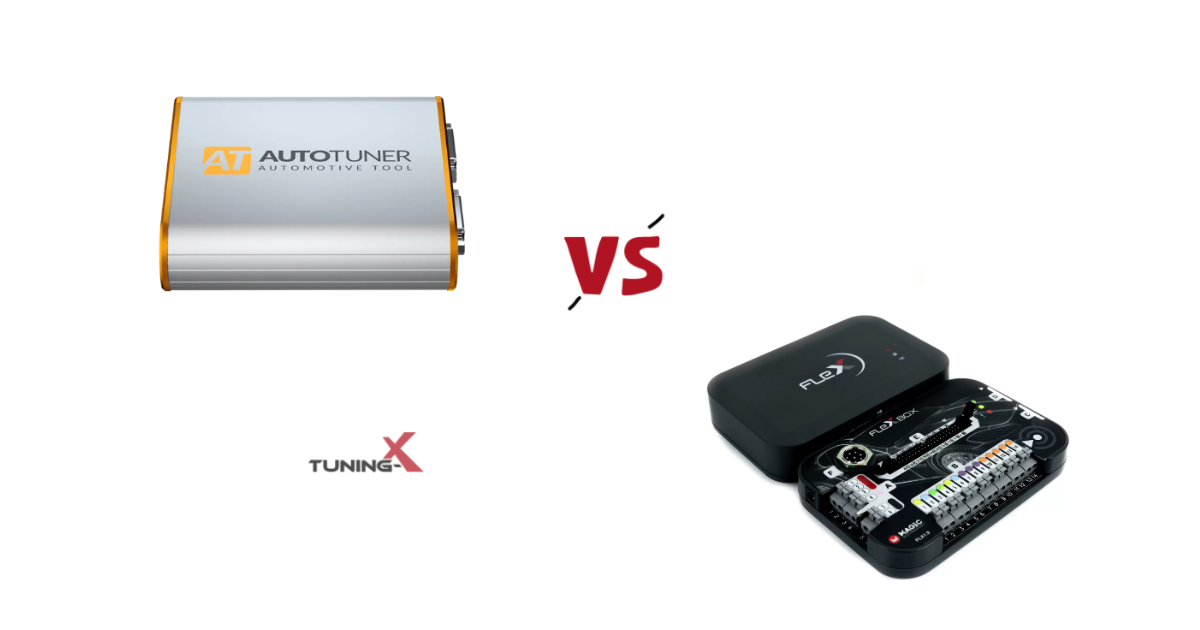Flex v2 Vs AutoTuner
Flex v2 Vs AutoTuner
In the rapid evolution of the automotive industry, chip tuning has become a crucial process for auto tuners seeking to optimize vehicle performance and customize it. Two of the leading chip tuning tools on the market are Flex v2 and AutoTuner, offering specific characteristics and benefits that are suitable to needs within chip tuning community. In this article, we will explore the key differences. We will also examine the advantages and disadvantages of these tools and determine which one might be the better choice according to specific requirements.
Flex v2 Overview
Flex V2 designed and developed by MagicMotorsport, is an advanced chip tuning and automotive diagnostics tool. It supports a vast range of makes and vehicles and is well known for its versatility. Flex v2 is the fully updated successor to the original flex and provides significantly improved tuning capabilities in terms of speed and efficiency.
Key Features of Flex v2 Include:
- Broad Vehicle Coverage: A vast array of vehicles is supported by Flex v2, including cars, trucks, motorcycles and agricultural machinery. Both OBD (On-Board Diagnostics) and Bench tuning can be handled by Flex v2 easily, and it is suitable for a variety of applications.
- High-Speed Data Transfer: One of the most important upgrades of Flex V2 is its enhanced data transfer speed. This makes the reading and writing of ECU (Engine Control Unit) data quicker during a chip tuning process, which is a critical key factor for tuners who can work on multiple vehicles in a short period.
- Modular Design: Whether OBD Tuning, bench tuning or even both, with its modular design, Flex V2 enables users to customize their tool according to their own needs.
- Regular updates: Flex V2 software is regularly updated by Magicmotosport, so all new vehicle models are included. This way, the tool remains relevant and capable of handling all the latest models in market.
- Advanced Safety Feature: Automatic checksum correction and recovery functions are included in Flex V2, so the risk of damaging the ECU during tuning is minimized.
AutoTuner Overview
Developed by the French company Autotuner, this tool has quickly become a favored choice among professional tuners due to its user-friendly design, efficiency, and reliability. It boasts robust capabilities that accommodate a diverse array of vehicles, including cars, trucks, and motorcycles, and is recognized for its rapid reading and writing capabilities.
Key features of AutoTuner include:
- Intuitive User Interface: AutoTuner is known for its easy-to-use software interface, which simplifies the chip tuning process. This makes it a great choice for those who are new to tuning or prefer a straightforward, hassle-free experience.
- Comprehensive Vehicle Support: Autotuner is compatible with a wide variety of vehicles, making it an ideal option for tuners who work with different types of automobiles.
- Rapid and Reliable Performance: The device provides swift reading and writing speeds, while maintaining stability. This enhances overall efficiency and minimizes tuning duration, making it a trusted tool for tuners.
- Cloud-Based Services: Autotuner employs a cloud system for software updates and file management, enabling users to access backup services and a database of original files from any location.
- No Subscription Fees: A notable characteristic of AutoTuner is its lack of ongoing subscription fees. Upon purchasing the tool, users gain access to all its features without incurring any further costs, which is particularly attractive to a wide range of users.
Comparative Analysis
When comparing Flex v2 and AutoTuner, several factors come into play, including vehicle compatibility, ease of use, speed, and cost.
Vehicle Compatibility and Coverage: Flex v2 and AutoTuner both support a wide range of vehicles, but Flex v2’s modular design might give users more opportunities for customization based on their unique requirements. Additionally, Flex v2 generally gets updates more often, which helps it remain compatible with the newest vehicle models.
Ease of Use: AutoTuner is frequently commended for its easy-to-use interface, which makes it perfect for newcomers or anyone who enjoys a straightforward tuning experience. On the other hand, Flex v2, although robust, may present a more challenging learning curve because of its sophisticated features and extensive customization possibilities.
Speed and Performance: Flex v2 stands out with its impressive high-speed data transfer features, making it a top choice for professionals who require quick tuning for multiple vehicles. On the other hand, AutoTuner also holds its ground, providing dependable speed and stability.
Cost and Value: AutoTuner’s one-time purchase model is a great benefit for users who want to avoid ongoing subscription fees. On the other hand, Flex v2, with its modular design and frequent updates, might lead to extra expenses in the long run. However, it provides enhanced features and safety measures that could make it worth the investment for dedicated tuners.
Support and Updates: Both tools offer consistent updates and robust support systems. That said, Flex v2 delivers updates more often and covers a wider range, which can be essential for professionals dealing with newer or less common vehicles.
Conclusion: Which One to Choose?
The decision to go with Flex v2 or AutoTuner really hinges on your individual requirements and how experienced you are.
Flex v2 with its modular design and high-speed capabilities sounds a good choice If you are a professional who require a high degree of customization, advanced features, and support to all the latest models. On the other hand, Autotuner with its intuitive interface, fast performance and luck of ongoing fees, it is a good choice if you are a professional who prioritize ease of use and dislikes of annual subscription.
Flex v2 and AutoTuner are both exceptional tools in the chip tuning field, making either a great choice for tuners. Ultimately, the choice depends on finding the right balance between advanced functionalities, user-friendliness, and budget.

 Cart
Cart 
